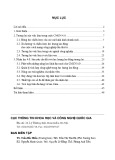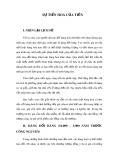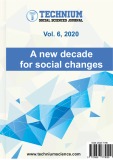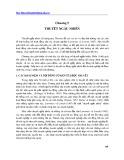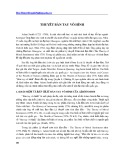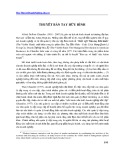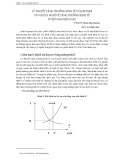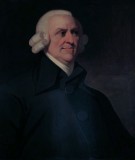
FTU Working Paper Series, Vol. 1 No. 2 (02/2022) | 164
PHÂN TÍCH VỀ MÔ HÌNH DUNNING VÀ CÁC HỌC THUYẾT LIÊN QUAN
Trần Thanh Như Hà1, Đinh Nguyễn Nhật Hân,
Nguyễn Thị Cúc Hương, Nguyễn Văn Hoàng Nhân
Sinh viên K57CLC3 – Kinh tế đối ngoại
Cơ sở II Trường Đại học Ngoại thương tại TP. Hồ Chí Minh, Việt Nam
Nguyễn Thúy Phương
Giảng viên Bộ môn Kinh tế - Luật
Cơ sở II Trường Đại học Ngoại thương tại TP. Hồ Chí Minh, Việt Nam
Tóm tắt
Bài viết này điều tra các yếu tố quyết định đến dòng vốn FDI ở các nước sở tại. Khung lý thuyết
được xây dựng trên cơ sở một số khái niệm liên quan đến FDI bao gồm Lý thuyết lợi thế sở hữu,
Lý thuyết lợi thế nội bộ hóa, Lý thuyết chiết trung của Dunning, lý thuyết FDI của Ozawa, Lý
thuyết thể chế và Lý thuyết về sự phù hợp của thể chế FDI. Các tác giả đã kết luận rằng, dựa trên
một số nghiên cứu trước đây, các biến số được coi là quan trọng trong việc thu hút FDI được cho
là khác nhau đáng kể giữa các lý thuyết này. Thông qua những lý thuyết đã được đề cập và
những nghiên cứu liên quan, nhóm tác giả đi đến kết luận bao quát rằng các yếu tố: thể chế, địa
điểm (bao gồm quy mô thị trường, chi phí lao động, nguyên vật liệu, v.v.) luôn có tác động đáng
kể và đóng vai trò quan trọng trong một quyết định đầu tư hay thu hút FDI đối với một quốc gia.
Từ khóa: Nguồn FDI, FDI nhận, Dòng vốn FDI, Lý thuyết chiết trung của Dunning.
A REVIEW OF OLI PARADIGM AND RELATED THEORIES
Abstract
This study investigates the determinants of FDI inflows in host countries. The theoretical
framework is based on several concepts related to FDI including Ownership advantage theory,
Internalization advantage theory, Dunning’s eclectic theory, FDI theory by Ozawa, Institutional
theory, and Institutional FDI fitness theory. The authors conclude that, based on a number of
prior research, the variables that are deemed crucial in attracting FDI vary significantly amongst
theories. Based on aforementioned theories and a wide range of related research, the group of
authors reach the broad conclusion that institutions, locations (including market size, labor costs,
raw materials, etc.) and always have a significant impact and play an important role in a
country's FDI decision.
Keywords: FDI inflows, FDI flow, Dunning’s eclectic theory, FDI.
1Tác giả liên hệ, Email: tranthanhnhuha1801015259@ftu.edu.vn
Working Paper 2022.1.2.12
- Vol 1, No 2

FTU Working Paper Series, Vol. 1 No. 2 (02/2022) | 165
1. Introduction
In such a context that the world is experiencing the globalization and trade liberalization
area with unprecedented nature and impact, foreign direct investment has been an integral part
of an open and effective international economic system and a major catalyst to development. In
fact, a substantial stream of research has investigated the role of FDI not only to the home
countries but also the host countries.
To be more precise, FDI triggers technology spillovers, assists human capital formation,
contributes to international trade integration, helps create a more competitive business
environment and enhances enterprise development which contributes to a higher economic
growth (OECD, 2002). Besides, FDI improves the competitiveness of goods produced in the
world market and the technical capabilities of importing countries, which, in turn, leads to an
increase in the employment rate in the country (Toshmurza et al, 2020). Moreover, FDI
presents an important source of new financial sources that will support local economies,
especially those in developing countries (Halil and Faruk, 2016).
Although there are many studies on the importance of attracting FDI, research on the
factors affecting FDI and circumstances in which FDI enters a country is quite scarce.
Therefore, two research-related questions are raised: What are the determinants of FDI flowing
into a country? And how are these factors related to the inner resources of the firms?
The Dunning eclectic paradigm (1979) provides a partial answer to these questions;
however, there is no consideration for the specific industry factors. Most previous papers only
focus separately on the host countries' factors that home country investors need to take into
consideration, or only on the home country advantages that affect FDI undertaking decisions,
without combining analysis of these factors. FDI by Ozawa is quite similar to the Dunning
model in terms of FDI attraction factors but different in the stages of investment strategy
transformation. The harmony between the internal and external needs of a country is highly
valued in attracting FDI when it comes to FDI fitness theory. Meanwhile, the management
policies and the role of the government are considered significantly when talking about
institutional theory. In order to stimulate this kind of research, this paper presents a review of
the literature on determinants that draw much attraction to undertake FDI regarding both
developing and developed countries and develops recommendations for further future research.
2. Methodology
Databases such as ResearchGate, Journal, SpringerOpen, Journal of Economics and
Development Studies and The Journal of International Business Research and Practice were
searched for the terms “foreign direct investment”, “determinants of FDI”, “FDI flow” and
“factors affecting FDI intentions”, focusing especially on research from the past 25 years for
this literature meta-analysis. In addition, we consulted the reference lists of relevant articles
and searched for more recent publications citing key publications on Google Scholar. As the
purpose of this literature review was to compile a great deal of findings from research sources,
the current review should be considered a narrative review (Booth et al, 2016).
3. Fundamental theory of factors affecting the foreign direct investment decisions
3.1 Ownership advantage

FTU Working Paper Series, Vol. 1 No. 2 (02/2022) | 166
This theory was created by Hymer (1960), which was the first efforts of publishing a
theory of humans to explain the trend of FDI. Hymer based on industrial economies
background and supposed that a company has to have a unique advantage, a.k.a monopoly
advantage, in case it has a desire to overcome oversea barriers and join in the producing
process (Mahoney et al., 2001).
According to Hymer (1960), there are two important elements that need to be considered
when investing in overseas. Firstly, a company should own competitive advantages to
overcome obstacles, difficulties, risks, etc. For example, some significant advantages are
product differentiation, the advantage of modern technologies, finance, or marketing. However,
licensing is complied with quality control risks and produce less profits compared to direct
production.
The second reason that encourages businesses to invest in another country is the ability to
overcome barriers in that country and on global markets. If a competitor has already developed
or entered a foreign market, the multinational business can cooperate and share the market with
the competitor, or control production operations directly in those foreign countries. Hymer's
theory attempted to demonstrate that in order for foreign direct investment to occur, the market
must be imperfectly competitive, resulting in benefits and drawbacks for businesses. Overseas
direct investment helps businesses remove barriers and use their advantages in foreign markets,
reducing competition pressure in the native market (Letto - Gillies, 2005).
Despite the fact that Hymer's hypothesis has identified several elements that influence FDI,
it still has some flaws:
1. It makes no discussion of the political and social effects of FDI on developing countries.
2. Hymer's theory does not mention any impactful policies on FDI influx.
3. This theory primarily considers the advantages that multinational corporations may gain
from investing abroad; it makes no mention of the advantages that investment recipients may
gain.
3.2 Internalization advantage theory
FDI happens when an internal transaction is better than a market transaction, according to
this view (Mahoney et al., 2001). Trading within the company is preferable to trading outside
the organization in an imperfect market. Market imperfections can be caused by a variety of
factors, including "natural imperfections" (distance between countries increases transportation
costs), "structural imperfections" (trade barriers between countries, such as product standards,
environmental regulations, and intellectual property rights requirements), and "technological
imperfections" (Kehal, 2004).
When the market isn't quite right, the corporation must create its own market by
establishing a trading environment within the organization, utilizing assets from the parent and
subsidiary companies or subsidiaries and subsidiaries. For example, if a company is having
difficulty purchasing petroleum goods on the market, it may seek to own a refinery.
Internalization helps to avoid time lags, purchase negotiating, and buyer shortages. When
buying iron ore, for example, a steel company may encounter raw material supply shortages
and high transaction expenses, especially if the ore is purchased from outside the country.

FTU Working Paper Series, Vol. 1 No. 2 (02/2022) | 167
However, if this firm purchases a foreign mining company, it can remove the scarcity of raw
materials by implementing internalization, which includes the acquisition of iron ore and
transportation costs.
In many circumstances, the benefits of internalization should outweigh the costs of
forming a parent subsidiary firm. However, this theory fails to explain the benefits of
internalization, provides no tangible proof, and is difficult to validate through empirical
investigation.
3.3 Dunning’s eclectic theory
Developed by British economist J.H Dunning in 1979, the eclectic theory, also called the
OLI model, was an economic framework for assessment of the determinants behind the
decision of making foreign direct investment (FDI) and the foreign activities of multinational
enterprises (MNEs). From the theory, there are three accommodating a wide range of
operational advantages behind the rationale of engaging in FDI activities: (1) Ownership
advantages (O), (2) Location advantages (L), (3) Internalization advantages (I).
More specifically, a business’s ownership advantage can also be considered as a
competitive advantage involving the advantages of technology, notable economies of scale,
comparative advantage from the proprietorship of some intangible assets such as patents and
brands as well as management skills over potential competitors. Ownership advantage is the
premise for FDI activities. In other words, the greater the ownership advantage that the
investing firms possess over other competitors in the foreign country, the greater is the chance
of them joining, or expanding their foreign investments.
Meanwhile, location advantage is achieved when a company investing in one location has
advantages that enable the company’s growth both at home and in a host country. Location
advantages focus more on the geographic advantages and other advantages including
availability of raw materials, large market size, low cost of production process factors, and a
favorable policy. Location advantage explains the reason why some countries are more
preferable than others.
The last one is the internalization advantage which may be seen as the interaction between
the two above advantages. This is the case when a firm chooses between carrying out
development internally and licensing the jurisdictions to means of enlargement to other firms.
In fact, if the net benefits of internalizing cross-border intermediate product markets surpass
that of exchanging through licensing or exporting the right to a foreign firm, there will be a
higher chance of firms preferring to engage in foreign production itself.
According to the eclectic theory, FDI only occurs if all three conditions mentioned above
are satisfied. Besides, O and I's advantages are seen as the “push” factors, while the advantage
L is the one who could "pull" the FDI. In other words, if O and I’s advantages give firms
chances to move to other areas, the L advantage is the property of a specific country. However,
these advantages vary over time, space, and development which also result in the change of
FDI inflows in each country, region, and period.
Furthermore, before making any decision, MNEs normally consider several places with
distinct factor endowments and the settlement of particular site alternative is built from the

FTU Working Paper Series, Vol. 1 No. 2 (02/2022) | 168
motives for FDI. On the report of the motives of MNEs undertaking FDI, their activities can be
divided into four categories:
● Market seeking: Supplying and serving the local market by taking advantage of the host
country;
● Efficiency seeking: Enhancing the efficiency of firm operations by combining the domestic
assets and foreign advantages;
● Resource seeking: Looking for a more stable and low-cost access to the resources;
● Strategic asset seeking: Reinforcing their own existing O specific advantages and/or to
weaken those of their competitors.
Nevertheless, not every scholar in the universal gave the full acceptance towards
Dunning’s eclectic theory. They were the advocates of internalization theory (e.g., Buckley
1981, 1983; Rugman 1981, Buckley and Casson 1985; Casson 1987) who showed the strongest
criticisms. To be more precise, they argued that the requisite and adequate factor to give an
explanation for the existence of MNEs could be the market imperfections in international
intermediate product markets. If Dunning’s O advantages were neither requisite nor adequate
to describe the presence of MNEs, then internalization theory would be considered as the
theory of the MNEs.
With regards to the condemnations of internalization theorists, Dunning made a number of
adjustments to his deprecators. To begin with, Dunning restructured O advantages into two
categories: “Oa (asset) advantages,” and “Ot (transactional) advantages”. Later, Dunning made
clear about the connections between internalization and the Ot advantages that O-specific
advantage could be appropriate to be referred as an advantage which is noticed thanks to
internalization as the modality despite the fact that some O-specific advantages resulted in a
straight line from firms internalizing the market for their intermediate products across national
borders since this put a between the internalizing firms and non-internalizing firms.
Moreover, Dunning differentiated between O and I advantage by using the notions of
ability and motivation of MNEs to internalize markets: while the company is given the
competence to internalize markets by O advantages, whereas the company is provided with the
motivation or willingness to internalize markets by I advantages. Both proficiency and
stimulus were in need of creating international production.
Throughout the decades, it could be said that Dunning (2003), “The eclectic (OLI)
paradigm of international production: Past, present and beyond,” laid out perhaps the most
absolute expression of his viewpoints on the OLI paradigm at the turn of the century. He
declared that the justifications bringing about the O, L, and I were still intact, and again
asserted that the objective of the paradigm was to explicate the level and pattern of
international production.
3.4 The Foreign Direct Investment theory by Ozawa (1992)
Foreign direct investment and economic development theory, also known as dynamic FDI
theory, was developed by Japanese economist T Ozawa in 1992. The theory was based on the
conceptual framework "stages theory of competitive development" by Michael Porter (1990).
Ozawa developed a comprehensive theory that describes the links between economic

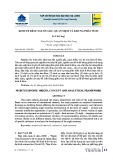
![Tương lai của năng suất: Tổng luận [Nghiên cứu mới nhất]](https://cdn.tailieu.vn/images/document/thumbnail/2021/20210201/caygaocaolon10/135x160/3821612151169.jpg)
